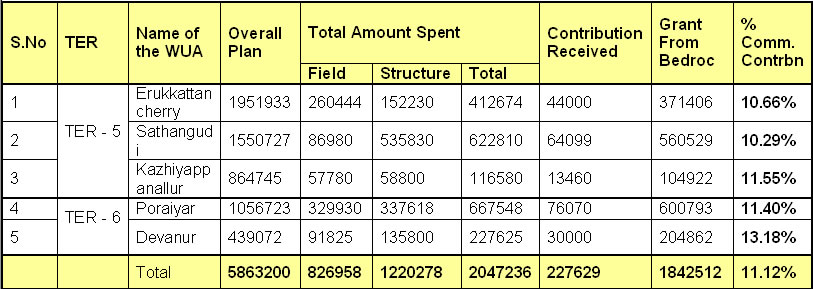
Participatory Water Resource Management
In an attempt to understand the vulnerabilities of the agrarian sector of Nagapattinam District, a study was done in late 2006. Interestingly, this study revealed that a majority of the disasters and subsequent losses faced by the long suffering agrarian communities here were not as much due to the hydro-meteorological conditions as due to the poor status of the 14 river systems running through the district before draining out into the Bay of Bengal.
Understanding the importance of effective water resources management for sustainable livelihood development, poverty reduction and resilience to disasters, BEDROC decided to tackle this issue through a participatory approach in water management. Water User Associations were formed in the ayacut area of the rivers chosen for intervention. These Water User Associations were capacitated to take on all activities pertaining to the river system in their village.
The Goal of this intervention was “To pilot a model for Sustainable Disaster Proofing of Agriculture in Nagapattinam” with the following specific objectives:
- Safe disposal of excess floodwater to mitigate water logging/inundation.
- Increase the availability of water through harvesting rain/flood water as well as improving recharge potential of the ground water.
- Contain backwater salination by improving the efficiency of the drainage channels
- Increase the intensity of cropping through improved irrigation systems
PWRMP Process



PWRMP Phase 1
Phase I of this project was started in 2007 and completed in 2008 at a cost of Rs. 35 lakhs. This initiative was supported by Concern Worldwide. The three river systems selected during the first phase of the project were:
1. The South Rajan river system under TER1
2. The Manjalaru river system under TER 4
3. The Kaduvayar river system under TER 9
While physical interventions were important, the project also believed in building up the capacities of the local communities in operating and maintaining their resources. 22 panchayat level wise Water User Associations were formed during this phase, which were later federated at the TER Level for holistic planning.
|
Sl No |
TER |
No. Panchayat |
Hamlets |
House Holds |
Population |
Ayacut Area |
Total farmers |
|
1 |
TER 1 |
2 |
9 |
928 |
3674 |
1230.6 |
514 |
|
2 |
TER 4 |
5 |
21 |
3307 |
16412 |
2806.56 |
1568 |
|
3 |
TER 9 |
15 |
54 |
7257 |
26470 |
6228.06 |
5047 |
|
|
|
|
|
|
|
|
|
The details of the work done in each of the 22 Panchayats are as shown below:

Recent Blog
- Hats off to the government’s servants
- Thane Cyclone: An Indication For Re-visioning Disaster Management
- Tsunami lessons for Tohoku from Tamil Nadu
- TRINet Newsletter February 2012
- Cyclone Thane -- Disaster Preparedness and Response
- TRINet Newsletter January 2012
- Impact of ICT on Climate Change and Agriculture in India
- TRINet Newsletter July 2011
- TRINet Newsletter May 2011
- The End of Days for Endosulfan










